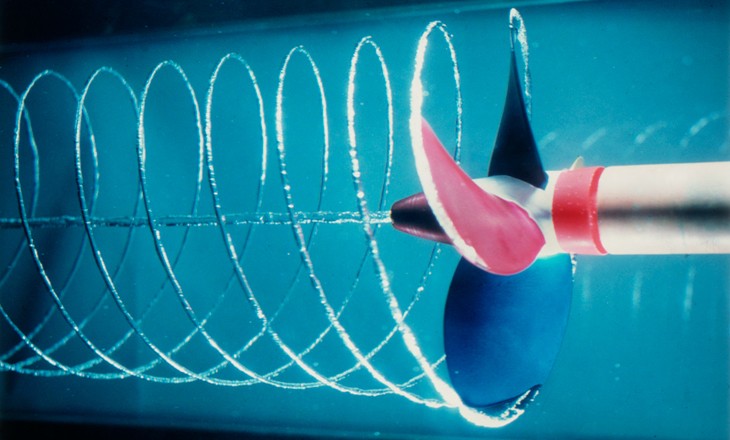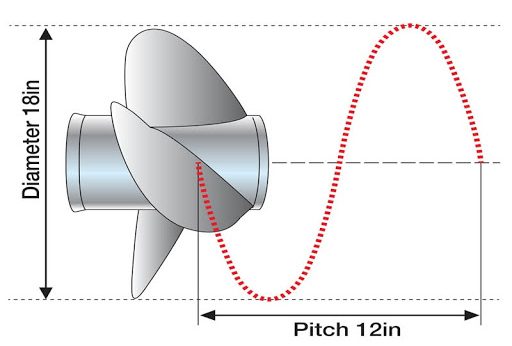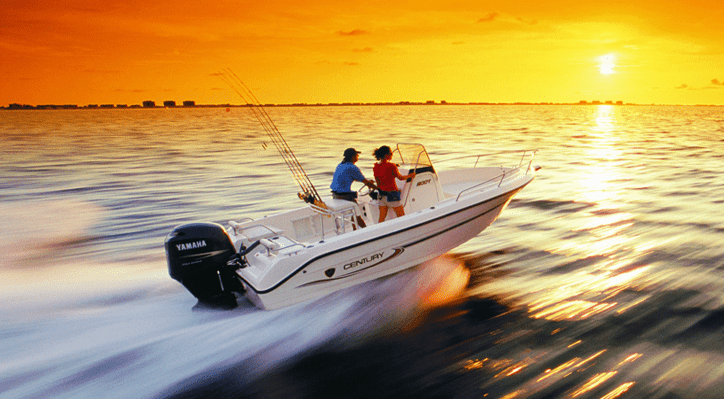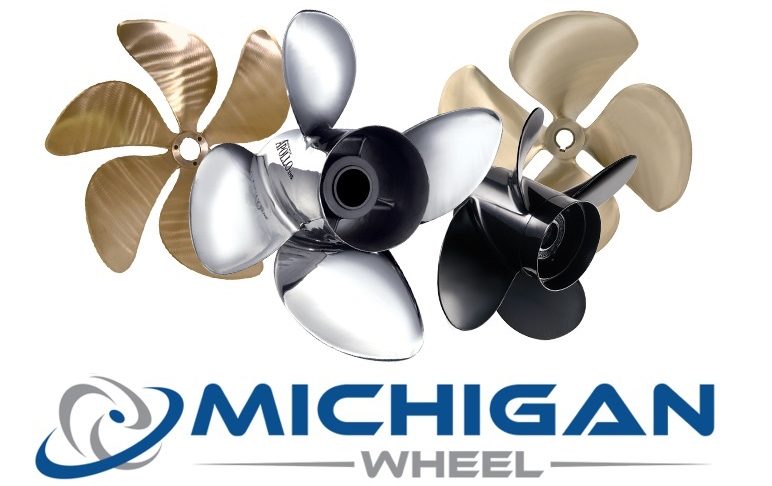How Propeller Pitch and Diameter Affect Boat Performance

When purchasing a new marine propeller, it is important to know what propeller pitch and diameter would best suit your boat. With this guide, you will learn not only what propeller pitch and diameter are, but how they affect your boat’s performance.
What is Propeller Pitch?

The propeller pitch is the distance that a propeller would move in one revolution if it were moving through a soft solid, like a screw through wood. It indicates the distance that a propeller would “drive forward” in each complete rotation.
For instance, a prop that moves forward 21 inches in one revolution is said to have a 21 inch nominal pitch.
In reality, since a marine propeller is attached to a shaft it won’t be driving forward, but will instead propel your boat forward. The distance a boat is propelled forward, however, is actually less than the pitch. The difference between the nominal pitch and actual distance traveled by the vessel in one rotation is called slip.
Typically blades are twisted to guarantee constant pitch along the blades from root to tip.
Propeller pitch effectively converts torque – the twisting or rotating effort – of the propeller shaft to thrust – the effort delivered by the propeller to push the vessel ahead – by deflecting or accelerating the water astern – simple Newton’s Second Law.
How Propeller Pitch Affects Your Boat Performance

The lower the propeller pitch, the better your “hole-shot”, or ability to get up to speed very quickly from a standstill. However, this improved acceleration comes at a price: top speed. Lower pitch will cause your engine to reach maximum rpm at slower speeds.
On the other hand, a higher pitch affects your boat performance by delivering greater top speeds, but at the expense of your acceleration or hole-shot. (Warning: lower-horsepower engines can bog down if fitted with a propeller with too high of a propeller pitch. This can cause heavy wear on the internal engine parts, who will have trouble keeping up).
If you’re changing the pitch on a recreational boat, there’s a rule of thumb often used that says each inch of pitch is generally worth 150 – 200 rpm. Lowering the pitch increases rpm and vice versa. So for instance, if you were to lower from a 23-pitch to a 21-pitch propeller, you’ll increase engine RPM by about 400 revolutions.
The trick is to choose a boat prop that delivers acceptable acceleration and a top speed.
Be prepared with vital information on your boat when purchasing a new boat prop, such as:
- Type of engine
- Horsepower rating and other engine specs you can bring
- Boat’s weight and hull style
- Current type of prop – number of blades, as well as diameter and pitch (usually stamped on prop)
What’s most important is your performance goals. If you load your boat with heavy gear, you might need a lower propeller pitch to get your boat moving from a standstill. If not weighed down by anything, you may just want a higher top speed, and in that case, a higher pitch is what you’d want.
Propeller Diameter and How It Affects Your Boat Performance – Propeller Diameter and RPM

The diameter of your boat propeller is how long it measures from the tip of one blade, straight across to the tip of an opposite blade (or where a blade tip would be). Easiest way to figure out is two times the distance from the center of the hub to the tip of any blade.
You figure out what propeller diameter you need mainly by the RPM at which the propeller will be turning and the amount of power that will be needed.
With the exception of high speed (35+ knots) vehicles, the diameter of the prop is proportional to propeller efficiency (higher diameter equals more efficiency). For most vessels, a small increase in diameter means a dramatic increase in thrust and torque. In higher speed vessels like mentioned above, however, a larger diameter equates to high drag.
Diameter generally increases for props on slower boats and decreases on faster boats.
Pitch Ratio of Your Propeller
You may come across the term pitch ratio when picking out a new propeller. This is simply the ratio of pitch to diameter, and generally falls between 0.5 and 2.5 with an optimal pitch ratio for most vessels closer to 0.8 to 1.8.
Looking for a New Prop? We Can Help
If looking for a new prop, contact us here or chat with us below, and we can help get you the correct prop for your boat. We carry Michigan Propellers. With more than 100 years of superior manufacturing, Michigan Wheel continues to make time-tested designs, dimensionally inspected using the latest electronic measurement equipment. Michigan Wheel’s high-quality propellers are made with certified virgin ingot metals, meaning no scrap and more consistent, durable propellers.
See the complete line of Michigan Props, here!
Have a good one!
Citimarine Store
3300 NW 112th Ave, #4
Doral, FL 33172
1-(800)-766-5256
CitimarineStore.com
–
Related Posts:










2 Comments
I was wondering if you could help me find a prop. I have a 2012 Chaparral 18 with a 3.0 Mercruiser. I am looking for a stainless steel prop. It currently has an aluminum 14.5 x 18 pitch prop. Thanks
Hi Chad, we can definitely help. Please reach out to our sales guys at 1 (800) 766-5256 or shoot them a message in the chat below!